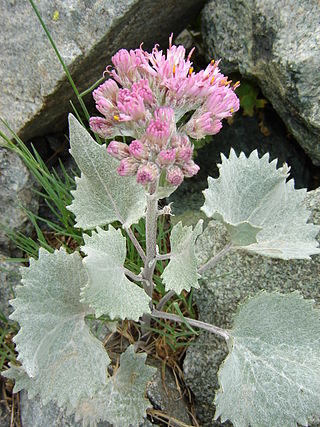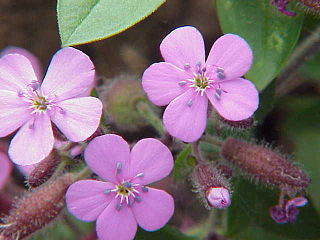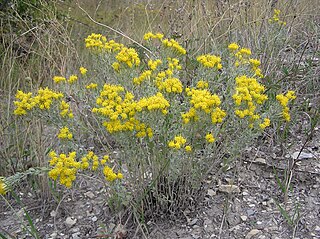
Medicago is a genus of flowering plants, commonly known as medick or burclover, in the legume family (Fabaceae). It contains at least 87 species and is distributed mainly around the Mediterranean Basin, and extending across temperate Eurasia and sub-Saharan Africa. The best-known member of the genus is alfalfa, an important forage crop, and the genus name is based on the Latin name for that plant, medica, from Greek: μηδική (πόα) Median (grass). Most members of the genus are low, creeping herbs, resembling clover, but with burs. However, alfalfa grows to a height of 1 meter, and tree medick is a shrub. Members of the genus are known to produce bioactive compounds such as medicarpin and medicagenic acid. Chromosome numbers in Medicago range from 2n = 14 to 48.

Senecio is a genus of flowering plants in the daisy family (Asteraceae) that includes ragworts and groundsels.

Adenostyles is a genus of flowering plants in the sunflower family Asteraceae, and of the tribe Senecioneae. It was described as a genus in 1816. Adenostyles occur in the temperate climates of the northern hemisphere, mainly in Europe and Asia Minor.

Saponaria is a genus of flowering plants in the family Caryophyllaceae, native to Asia and Europe, and are commonly known as soapworts. They are herbaceous perennials and annuals, some with woody bases. The flowers are abundant, five-petalled and usually in shades of pink or white. The genus is closely related to the genus Silene, being distinguished from these by having only two styles in the flower. It is also related to Gypsophila, but its calyx is cylindrical rather than bell-shaped.

Anthemis is a genus of aromatic flowering plants in the family Asteraceae, closely related to Chamaemelum, and like that genus, known by the common name chamomile; some species are also called dog-fennel or mayweed. Anthemis are native to the Mediterranean region and southwest Asia east to Iran. A number of species have also become naturalized in the United Kingdom and other parts of the world.

The genus Carthamus, the distaff thistles, includes plants in the family Asteraceae. The group is native to Europe, North Africa, and parts of Asia. The flower has been used since ancient times in the Philippines, which it has been called kasubha by the Tagalog people.

Lomelosia caucasica, the Caucasian pincushion flower, pincushion-flower or Caucasian scabious, is a species of flowering plant in the family Caprifoliaceae, native to the Caucasus, north eastern Turkey, and northern Iran. Growing to 60 cm (24 in) tall and broad, it is a clump-forming perennial with grey-green, divided leaves. Pincushion-shaped buds, borne on erect hairy, stems, open to pale blue or lavender flower heads, 4–8 cm (2–3 in) in diameter, from late summer through to autumn.
In botany, the correct name according to the International Code of Nomenclature for algae, fungi, and plants (ICN) is the one and only botanical name that is to be used for a particular taxon, when that taxon has a particular circumscription, position and rank. Determining whether a name is correct is a complex procedure. The name must be validly published, a process which is defined in no less than 16 Articles of the ICN. It must also be "legitimate", which imposes some further requirements. If there are two or more legitimate names for the same taxon, then the correct name is the one which has priority, i.e. it was published earliest, although names may be conserved if they have been very widely used. Validly published names other than the correct name are called synonyms. Since taxonomists may disagree as to the circumscription, position or rank of a taxon, there can be more than one correct name for a particular plant. These may also be called synonyms.
Werner Rodolfo Greuter is a botanist. He is the chair of the Editorial Committee for the International Code of Botanical Nomenclature (ICBN) - the Tokyo Code (1994) and the St Louis Code (2000). His proposed policy as regards registration of botanical names proved unpopular and in 1999 he stepped back, not being elected anew: he completed his term as chair to be succeeded at Vienna in 2005. He has returned as a member of the editorial committee, contributing to the renamed International Code of Nomenclature for algae, fungi, and plants, the "Melbourne Code" (2012).

Jacobaea is a genus of flowering plants in the tribe Senecioneae and the family Asteraceae. Its members used to be placed in the genus Senecio, but have been separated into the segregate genus Jacobaea on the basis of molecular phylogenetics in order to maintain genera that are monophyletic.

Senecio squalidus, known as Oxford ragwort, is a flowering plant in the daisy family Asteraceae. It is a yellow-flowered herbaceous plant, native to mountainous, rocky or volcanic areas, that has managed to find other homes on man-made and natural piles of rocks, war-ruined neighborhoods and even on stone walls. These habitats resemble its well drained natural rocky homeland. The plants have spread via the wind, rail and the activities of botanists. The travels of this short-lived perennial, biennial, or winter annual make it a good subject for studies of the evolution and ecology of flowering plants.

Jacobaea gibbosa is a species of the genus Jacobaea and the family Asteraceae.

Galatella is a genus of flowering plants in the family Asteraceae, native to Europe, Asia, and northern Africa.
Caucasalia is a genus of flowering plants in the daisy family.

Dolichorrhiza is a genus of flowering plants in the sunflower family.
Iranecio is a genus of flowering plants in the sunflower family, native to the eastern Mediterranean east to the Caucasus.

Anthemis cretica, the Cretian mat daisy or white mat chamomile, is a species of flowering plant in the family Asteraceae. It or its many subspecies can be found around the Mediterranean region, the Black Sea area, Poland, the Caucasus, and the Middle East as far as Iran. It is highly morphologically variable, and the namesake of a species complex.

Lomelosia is a genus of flowering plant in the family Caprifoliaceae and the subfamily of Dipsacoideae. The genus includes over 50-63, perennial and annual species, diffused around the Mediterranean Sea, with the greatest diversity of species concentrated in the eastern Mediterranean and the Middle East, and also has a few species reaching as far east as China.













